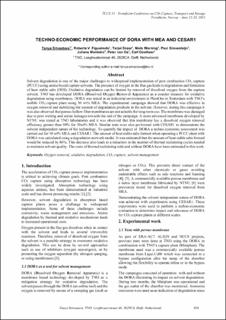| dc.contributor.author | Srivastava, Tanya | |
| dc.contributor.author | Figueiredo, Roberta V. | |
| dc.contributor.author | Skaar, Tarjei | |
| dc.contributor.author | Warning, Niels | |
| dc.contributor.author | Gravesteijn, Paul | |
| dc.contributor.author | Monteiro, Juliana | |
| dc.contributor.author | Van Os, Peter | |
| dc.contributor.author | Goetheer, Earl | |
| dc.date.accessioned | 2021-09-30T09:35:32Z | |
| dc.date.available | 2021-09-30T09:35:32Z | |
| dc.date.issued | 2021 | |
| dc.identifier.isbn | 978-82-536-1714-5 | |
| dc.identifier.issn | 2387-4295 | |
| dc.identifier.uri | https://hdl.handle.net/11250/2786528 | |
| dc.description.abstract | Solvent degradation is one of the major challenges to widespread implementation of post combustion CO2 capture (PCCC) using amine based capture solvents. The presence of oxygen in the flue gas leads to degradation and formation of heat stable salts (HSS). Oxidative degradation can be limited by removal of dissolved oxygen from the capture solvent. TNO has developed DORA (Dissolved Oxygen Removal Apparatus) as a counter measure for oxidative degradation using membranes. DORA was tested in an industrial environment at PlantOne in Rotterdam with TNO’s mobile CO2 capture plant using 30 wt% MEA. The experimental campaign showed that DORA was effective in oxygen removal and stabilizing the amount of degradation products in the solvent, However, during this campaign it was also observed that porous hollow fiber membranes are not suitable for long-term use. The membrane was damaged due to pore wetting and amine leakages towards the end of the campaign. A more advanced membrane developed by NTNU was tested at TNO laboratories and it was observed that this membrane has a dissolved oxygen removal efficiency greater than 90% for 30wt% MEA. Similar tests were also performed with CESAR1 to demonstrate the solvent independent nature of the technology. To quantify the impact of DORA a techno economic assessment was carried out for 30 wt% MEA and CESAR1. The amount of heat stable salts formed when operating a PCCC plant with DORA was calculated using a degradation network model. It was estimated that the amount of heat stable salts formed would be reduced by 86%. This decrease also leads to a reduction in the number of thermal reclaiming cycles needed to maintain solvent quality. The costs of thermal reclaiming with and without DORA have been estimated in this work. | en_US |
| dc.language.iso | eng | en_US |
| dc.publisher | SINTEF Academic Press | en_US |
| dc.relation.ispartof | TCCS–11. CO2 Capture, Transport and Storage. Trondheim 22nd–23rd June 2021.
Short Papers from the 11th International Trondheim CCS Conference | |
| dc.relation.ispartofseries | SINTEF Proceedings;7 | |
| dc.rights | CC BY 4.0 | * |
| dc.rights.uri | https://creativecommons.org/licenses/by/4.0/ | * |
| dc.subject | Oxygen Removal | en_US |
| dc.subject | Oxidative Degradation | en_US |
| dc.subject | CO2 Capture | en_US |
| dc.subject | Solvent Management | en_US |
| dc.title | Techno-Economic Performance of Dora with Mea and Cesar1 | en_US |
| dc.type | Chapter | en_US |
| dc.type | Peer reviewed | en_US |
| dc.type | Conference object | en_US |
| dc.description.version | publishedVersion | en_US |
| dc.rights.holder | © 2021 The Authors. Published by SINTEF Academic Press. | en_US |
| dc.subject.nsi | VDP::Teknologi: 500 | en_US |

